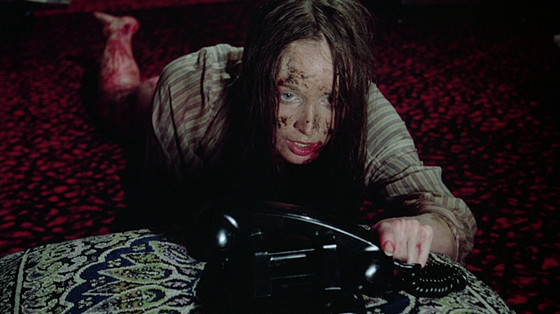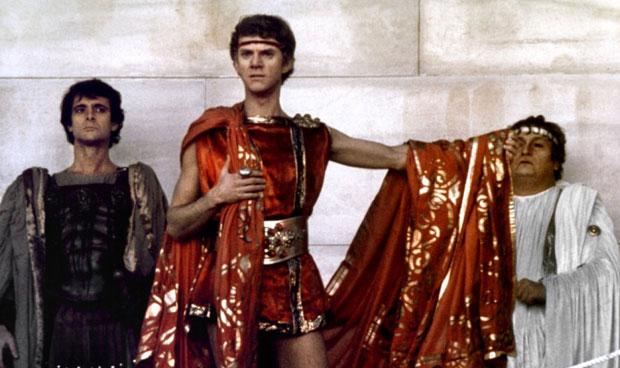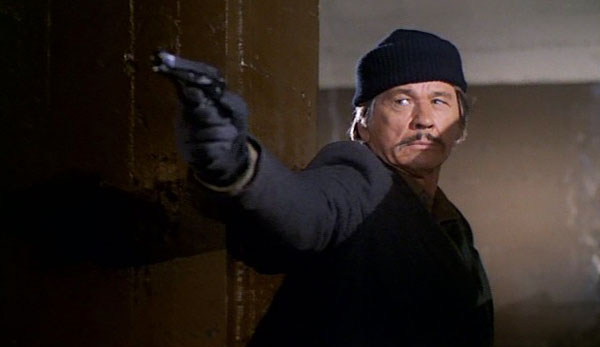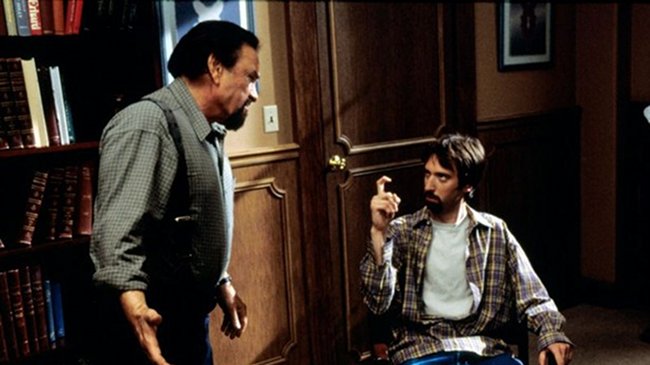6. I Spit On Your Grave (1978)

The Plot, In One Sentence: After being repeatedly raped, a young woman plots revenge on the four sex criminals who left her for dead – impalements, strangulations, castration and a dude having his face chopped off by a motorboat ensues.
What Ebert Said: “A vile bag of garbage named ‘I Spit on Your Grave’ is playing in Chicago theaters this week. It is a movie so sick, reprehensible and contemptible that I can hardly believe it’s playing in respectable theaters, such as Plitt’s United Artists. But it is. Attending it was one of the most depressing experiences of my life.”
Why You Should Watch It Anyway: Again, much of Ebert’s damning review focused not on the content of the film itself, but rather, his disgust with the audience’s reaction to it. While Ebert perplexingly viewed the film as a misogynistic work, others have since championed it as a pioneering feminist horror film and one of the first major motion pictures to directly address “rape culture” as the horrible, disgusting thing it really is.
The film is graphic and revolting and makes you feel sad and depraved, but that’s the point; if you’re going to condemn a horror film for inspiring shock, dread and discomfort, then why not condemn comedy films for being funny, or condemn Schindler’s List for making you feel sad? We still respect you, Roger, but your reasoning on this one just doesn’t make any sense.
7. Caligula (1979)

The Plot, In One Sentence: Penthouse Magazine proudly presents the world’s first historical drama/exploitation gorefest/hardcore pornography mega-epic, believe it or not starring real actors and actresses like Malcolm McDowell, Peter O’Toole and Helen Mirren.
What Ebert Said: ‘Caligula’ is sickening, utterly worthless, shameful trash. If it is not the worst film I have ever seen, that makes it all the more shameful: people with talent allowed themselves to participate in this travesty. Disgusted and unspeakably depressed, I walked out of the film after two hours of its 170-minute length.”
Why You Should Watch It Anyway: Despite Ebert’s thrashing of the film, Caligula remains a legit cult classic that 40 years later, still feels like it’s ahead of its time. In every sense of the word, Caligula is a movie with adult sensibilities, specifically targeting adult palates – had it been a financial success, it could’ve changed the film industry forever, perhaps making daring NC-17 fare not only economically viable, but maybe even mainstream.
Alas, Caligula’s pioneering merger of the fantastically explicit and the authentically explicit has palpably influenced the medium, as evident by its impact on the filmography of Gaspar Noe and Lars Von Trier. And considering Caligula’s extreme violence, graphic sexual content, fantastical sets and over-the-top acting, one can’t help but detect just a slight tinge of its inspiration on TV shows like Game of Thrones and Outlander.
8. Mother’s Day (1980)

The Plot, In One Sentence: Three women get abducted by two insane hillbillies in the New Jersey woods, whose deranged mama commands them to maim, mutilate and murder for her amusement.
What Ebert Said: “After the first five minutes of ‘Mother’s Day’ – after the shot of the blood spurting from the severed neck of the movie’s first victim – I was ready to walk out … the question, of course, of why anybody of any age would possibly want to see this film remains without an answer.”
Why You Should Watch It Anyway: Outside of being one of the best Troma movies ever (which I suppose is kinda’ like having the highest grades in remedial math), it’s just a damn creepy rape-revenge/slasher hybrid.
The last 20 minutes, in particular, are among the most jam-packed of any early 1980s horror flick, with ropes digging into women’s bloody hands, dudes getting Drano poured down their their throats and a surprise attack at the very end of the film that seems to eerily portend the ending of Friday the 13th.
Furthermore, the acting in this one is WAY better than what you would find in 90 percent of genre films from the time frame and the soundtrack is unexpectedly solid. Casablanca it ain’t, but compared to its subgenre contemporaries, Mother’s Day is definitely one of the better, more unique and unquestionably effective films of its type from the era.
9. Death Wish II (1982)

The Plot, In One Sentence: Vigilante hero Chuck Bronson moves to California to begin his life anew – then, a buncha’ no-good thugs murder his daughter, and he has to paint the barrios of Los Angeles blood red.
What Ebert Said: “What’s most shocking about ‘Death Wish II’ is the lack of artistry and skill in the filmmaking. The movie is underwritten and desperately underplotted, so that its witless action scenes alternate with lobotomized dialogue passages. The movie doesn’t contain an ounce of life. It slinks onto the screen and squirms for a while, and is over.”
Why You Should Watch It Anyway: OK, so the film isn’t as good as the original, but just how many sequels manage to outdo their forerunner? Death Wish II might be a step down from the original film, but it’s not a sudden plunge into the abyss like Ebert declares. In fact, as a braindead vigilante action flick from the veritable golden age of braindead vigilante action flicks, it’s definitely one of the better in the subgenre in terms of acting, pacing and atmosphere.
Nobody expects a gourmet meal at Taco Bell, and nobody expects perspective-broadening enlightenment from an early ‘80s Cannon action movie – so why should anybody complain about such cheap and cheesy products when they adequately serve their purpose as unrefined, instantly gratifying junk? And even if Death Wish 2 isn’t that great, compared to subgenre contemporaries like The Exterminator 2, The Executioner Part 2, The Eliminator and Intruder, it’s basically Seven freakin’ Samurai.
10. Freddy Got Fingered (2001)

The Plot, In One Sentence: MTV star Tom Green presents a bizarro comedy about a wannabe cartoonist whose favorite pastimes include tormenting his overbearing father, dressing up in bloody deer carcasses and whacking his paraplegic girlfriend’s legs with a crowbar for sexual pleasure.
What Ebert Said: “This movie doesn’t scrape the bottom of the barrel. This movie isn’t the bottom of the barrel. This movie isn’t below the bottom of the barrel. This movie doesn’t deserve to be mentioned in the same sentence with barrels … the day may come when ‘Freddy Got Fingered’ is seen as a milestone of neo-surrealism. The day may never come when it is seen as funny.”
Why You Should Watch It Anyway: Freddy Got Fingered is more or less the last great film Luis Bunuel never directed. Even in his own review, Ebert likens the film to Un Chien Andalou and the work of Andy Kaufman, which pretty much describes the intrinsic genius of Tom Green’s box office disaster.
In a way, the much maligned flick is a brilliant deconstruction of the gross-out teen comedy, depicting the borderline sociopathic behavior displayed by your average Adam Sandler character as unnerving horror instead of lowest common denominator-pandering humor.
Salvador Dali would have been proud of the ingenious trick this film pulled on the moviegoing masses; even though it was marketed as humorous, from the get-go Freddy Got Fingered was designed to inspire as much audience revulsion as possible. Ebert’s scathing review, interestingly, nails why the film is an unheralded masterpiece – it may be turgid as a comedy, but as a daring work of post-post-postmodern art, it certainly is a “milestone of neo-surrealism.”
Author Bio: James Swift (@UNJournalism) is an Atlanta-based writer and reporter whose work has been published by the Juvenile Justice Information Exchange, Youth Today, the Center for Public Integrity, the Marietta Daily Journal, AOL, Thought Catalog, The Roswell and Alpharetta Neighbor, The North Fulton Business Journal and the Journal of Blacks in Higher Education. His multimedia project “Rural America: After the Recession” received acclaim from both the Community Action Partnership and the Casey Journalism Center on Children and Families, and in 2013, he wrote the foreword for Jan Banning’s “Down and Out in the South.”